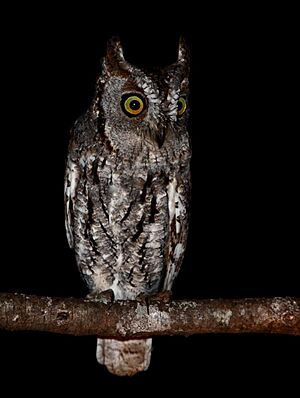African scops owl facts for kids
Quick facts for kids African scops owl |
|
|---|---|
 |
|
| Roosting at Lake Baringo, Kenya | |
| Conservation status | |
| Scientific classification |
The African scops owl (Otus senegalensis) is a small owl that lives across a large part of sub-Saharan Africa. It's known for its excellent camouflage, which helps it blend into its surroundings.
Contents
About the African Scops Owl
Scientists group living things into categories. This helps us understand how they are related. The African scops owl was first described in 1837 by a scientist named William Swainson. He first put it in a different group, but now it's part of the Otus owl family.
There are a few different types, or 'subspecies', of the African scops owl:
- Otus senegalensis senegalensis: This is the most common type, found all over sub-Saharan Africa.
- Otus senegalensis nivosus: This type lives in a specific area of south-eastern Kenya.
- Otus senegalensis feae: This special type is only found on Annobón island in the Gulf of Guinea. Some scientists think it might even be its own separate species, called the Annobón scops owl!
The African scops owl was once thought to be the same as the European scops owl. However, scientists now know they are different species. Other similar owls, like the Arabian scops owl and Socotra scops owl, are also now considered separate species.
What Does It Look Like?
The African scops owl is a small bird, usually about 17 cm (6.7 inches) long. It's mostly greyish-brown, but some can be a bit reddish or warmer brown. Its feathers have streaks and spots that help it blend in with tree bark. This is called camouflage!
It has bright yellow eyes and a grey face with a thin black edge. It also has 'ear-tufts' on its head. These aren't really ears, but small feathers that usually lie flat. If the owl feels scared or disturbed, it can raise these tufts to look like broken branches, helping it hide even better. Its wingspan is about 45 cm (18 inches).
What Sound Does It Make?
The African scops owl has a unique call. It makes a quiet, vibrating sound that sounds like "prrrp." It repeats this sound about every five seconds.
Is It Easy to Confuse With Other Owls?
The European scops owl looks very much like the African scops owl. The European one is usually a little bigger, but it can be very hard to tell them apart just by looking at them in nature.
Where Does It Live?
The African scops owl lives only in sub-Saharan Africa. You can find it from sea level all the way up to 2,000 meters (about 6,500 feet) high. It likes places with trees, like forests, the edges of forests, gardens, and even mangrove swamps.
How Does It Behave?
The African scops owl is a 'nocturnal' animal, which means it is active at night. During the day, it rests, or 'roosts', very close to the trunk of a tree. When it's sleeping, it often closes its eyes and stretches out its ear-tufts. This makes it look like a broken tree branch, so it's very hard to spot! Sometimes, a pair of owls will roost together.
Unlike some other owls, the African scops owl isn't very protective of its territory. They might even build their nests quite close to each other.
The male and female owls sometimes sing together, calling all night long, both before and after they leave their roosting spot. The female owl lays four to six eggs directly onto the floor of a tree hollow. This usually happens between April and June. The female sits on the eggs for about 27 days to keep them warm. During this time, the male owl brings her food. Once the eggs hatch, the young owls are fed by the female, who gets food from the male. The young owls are ready to fly after about 30 days.
The African scops owl mainly eats insects like grasshoppers, beetles, crickets, and moths. They also eat spiders, scorpions, and sometimes small animals with backbones, called vertebrates. They usually hunt by sitting on a branch, listening and watching for prey. Then, they swoop down to catch it on the ground. They can also catch flying insects in the air.



